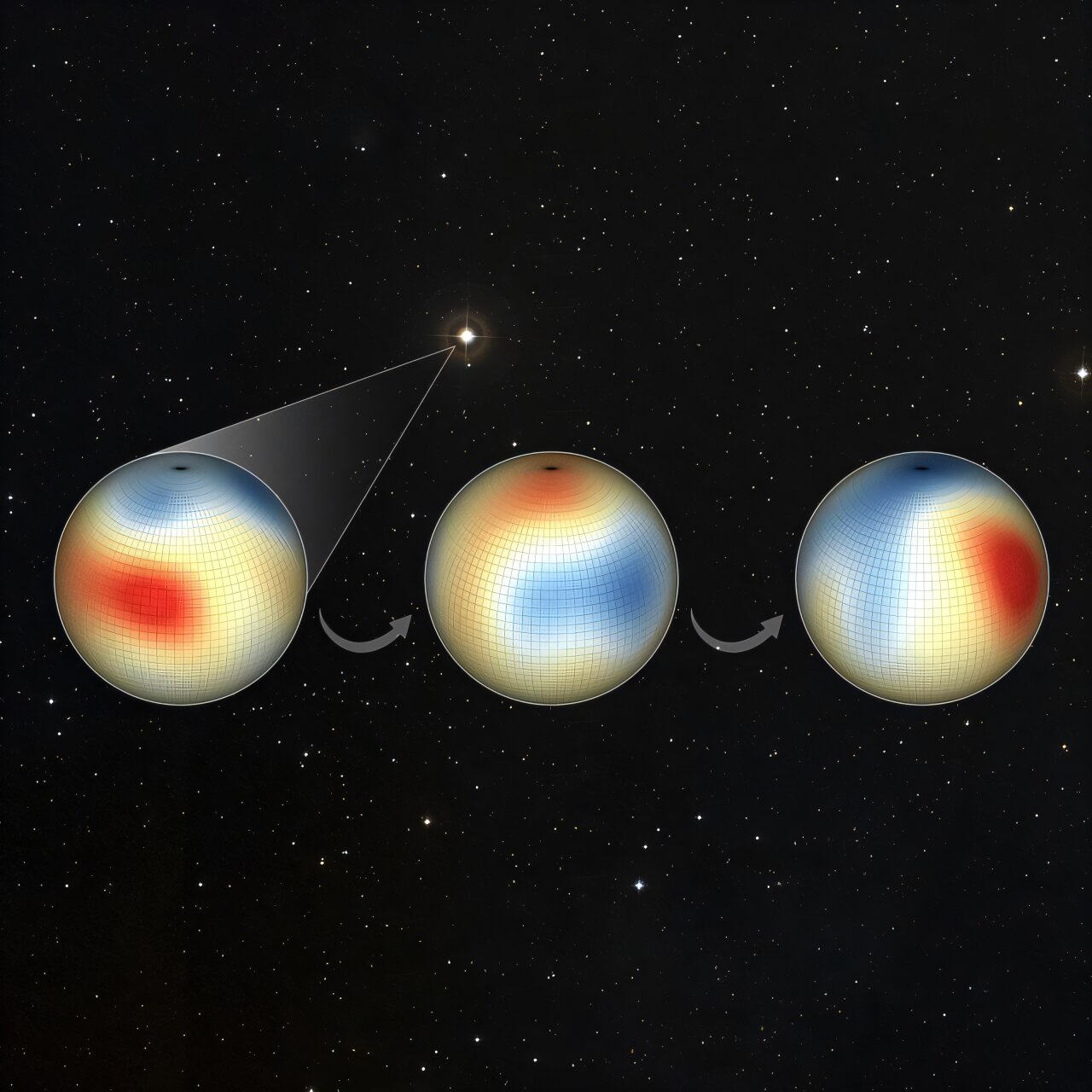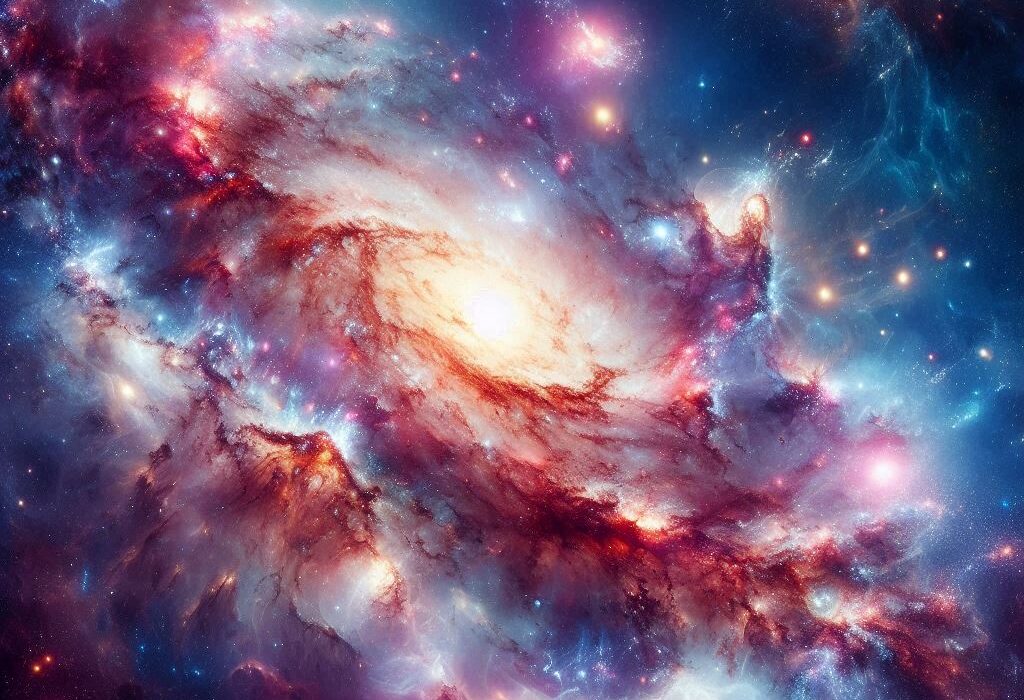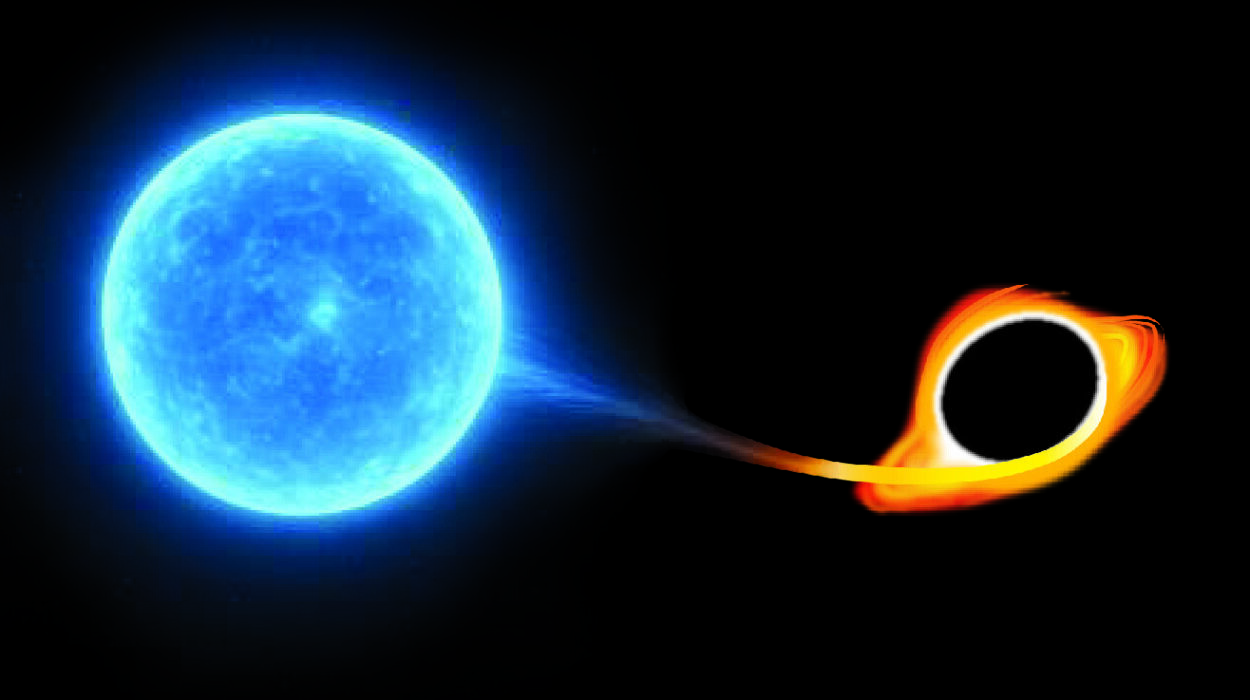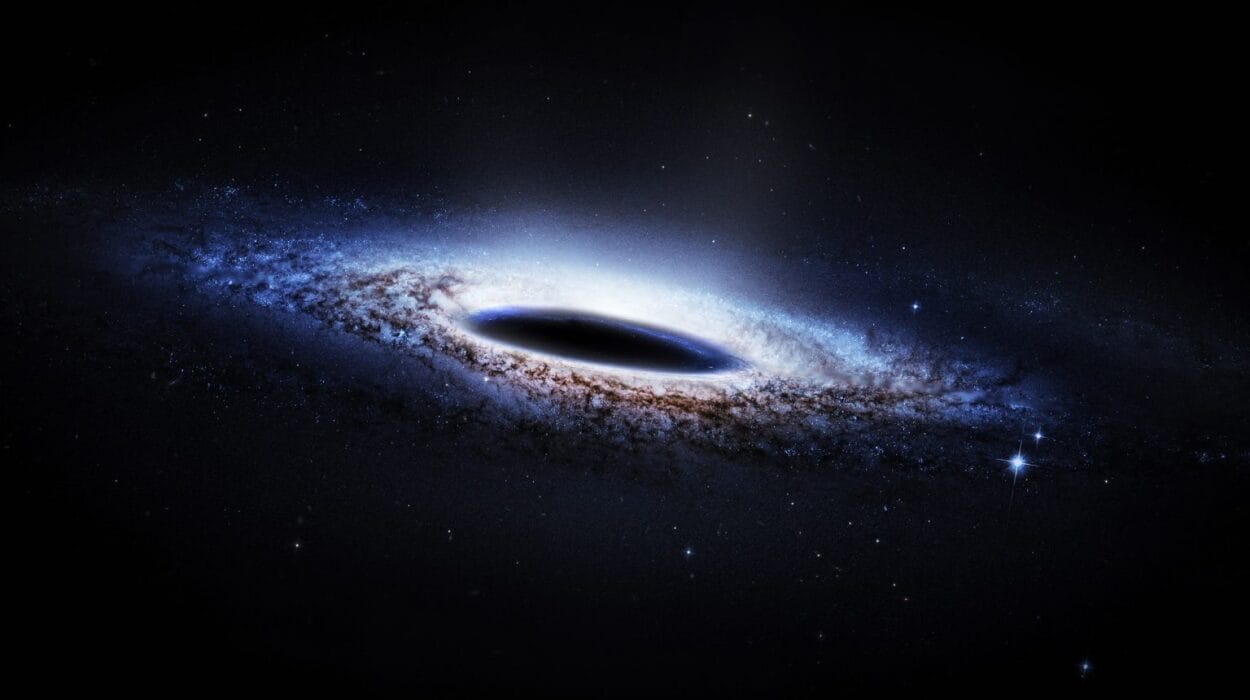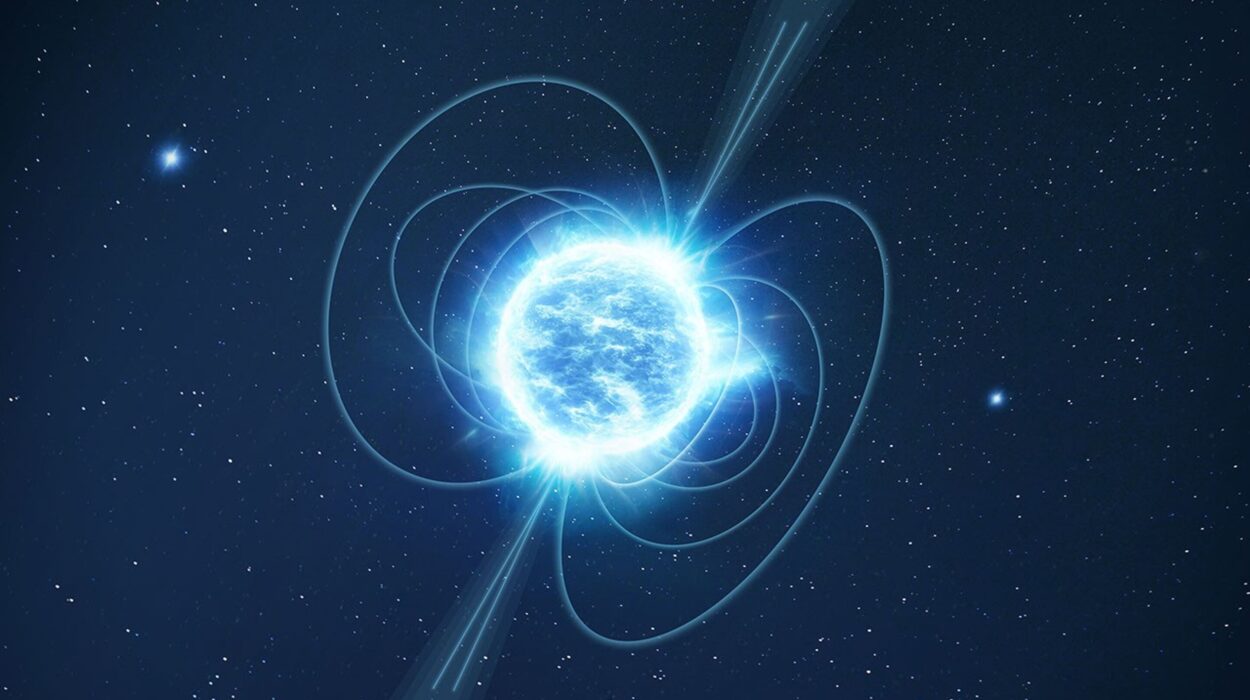Fifty-six light-years from Earth, in the southern constellation Horologium—the celestial clock—beats the magnetic heart of a star called Iota Horologii, or ι Hor. Though invisible to the naked eye, this young star has become a window into the early life of suns like our own. To scientists at the Leibniz Institute for Astrophysics Potsdam (AIP), ι Hor is not just another point of light. It is a time machine, showing us what our sun might have looked like when it was young, restless, and full of energy.
At roughly 600 million years old, ι Hor is still in its stellar youth. Compared to our 4.6-billion-year-old sun, it spins faster, flares brighter, and its magnetic field thrums with extraordinary vigor. For nearly three years, astronomers from AIP tracked this star’s every move, every pulse of magnetism, and every twist in its magnetic field, uncovering patterns that have never been seen beyond our solar system.
Their findings, part of the “Far Beyond the Sun” research campaign, reveal that ι Hor possesses a dynamic magnetic cycle—a kind of cosmic heartbeat—that flips its magnetic poles every two years. This discovery, published in “Far Beyond the Sun III: The Magnetic Cycle of ι Horologii” on the arXiv preprint server, offers new insights into one of the most profound mysteries of astrophysics: how stars generate and evolve their magnetic fields.
The Magnetic Soul of a Star
Magnetic fields are the invisible engines that drive the behavior of stars. They shape everything from the dark sunspots that blemish a stellar surface to the blazing flares that hurl particles across space. On Earth, the sun’s magnetic mood determines space weather—storms of charged particles that can disrupt satellites, power grids, and even our planet’s atmosphere.
The sun’s magnetic cycle, which lasts about 22 years, is the rhythm behind this activity. Every 11 years, the sun’s north and south magnetic poles flip, and the cycle begins again. But for ι Hor, this cosmic dance happens much faster. Its full magnetic cycle lasts just over two years—773 days to be precise—making it one of the fastest stellar dynamos ever observed.
This discovery means that young stars like ι Hor don’t just spin faster; they live in fast-forward, experiencing magnetic seasons that come and go at a breathtaking pace. Their internal magnetic engines churn with far greater intensity than the sun’s, offering a glimpse into how magnetic fields evolve as stars age and slow down.
The Art of Seeing the Invisible
To uncover ι Hor’s hidden magnetic structure, AIP scientists used a powerful instrument called HARPS-Pol, a high-precision polarimeter attached to the 3.6-meter telescope at the European Southern Observatory’s La Silla Observatory in Chile. Over 199 nights, spread across six observing seasons, they gathered spectropolarimetric data—measurements of light that reveal subtle fingerprints of magnetic fields on a star’s surface.
But collecting the light was only the first step. Turning it into a map required a technique known as Zeeman Doppler Imaging (ZDI). This method allows scientists to reconstruct a star’s magnetic field by analyzing how its light changes as it rotates. Like doctors creating an MRI scan of the human body, astronomers used ZDI to generate 18 distinct “magnetic maps” of ι Hor, each capturing a different phase of its magnetic evolution.
These maps are breathtaking in their implications. They show magnetic regions emerging, fading, and even flipping polarity, like waves of energy rolling across the star’s surface. Over roughly 140 rotations of ι Hor, the researchers watched the star’s magnetic north and south poles switch places—a celestial heartbeat pulsing far faster than the one that drives our own sun.
The First Magnetic Butterfly Beyond the Sun
One of the most extraordinary achievements of the study is the creation of the first magnetic butterfly diagram for a star other than our sun. On Earth, solar physicists use such diagrams to track the movement of sunspots and magnetic features across the sun’s surface. Over the course of its magnetic cycle, sunspots tend to emerge at mid-latitudes and gradually migrate toward the equator, forming a pattern that resembles the wings of a butterfly.
Now, for the first time, astronomers have drawn such a diagram for another star. By averaging the magnetic field strength of ι Hor at different latitudes for each observing period, AIP scientists created a time-lapse of its magnetic activity. The result is a living portrait of a young, sun-like star in motion—its magnetic regions drifting toward the poles and equator in a rhythmic pattern that mirrors, yet outpaces, our sun’s behavior.
The butterfly wings of ι Hor spread and contract much faster than those of the sun. In its two-year cycle, the star’s magnetic features migrate across its surface at remarkable speeds—15 to 78 meters per second toward the poles, and 9 to 19 meters per second toward the equator. To put that into perspective, these magnetic flows move as fast as a speeding train or a city car, while the corresponding flows on the sun are significantly slower.
This marks the first time such meridional and equatorward flows have ever been measured on a star other than our own. For astrophysicists, it’s a revelation: these flows are key ingredients in the magnetic dynamo that powers stellar activity.
A Window into Stellar Dynamos
What drives these magnetic rhythms? Deep within a star’s interior, vast currents of plasma swirl and twist, generating magnetic fields through a process known as the stellar dynamo. It’s a self-sustaining engine: rotating plasma creates magnetic fields, which in turn influence the plasma’s motion, creating feedback loops of unimaginable complexity.
In the sun, this process operates slowly and steadily. But in ι Hor, everything runs on overdrive. The star’s rapid rotation—much faster than the sun’s 27-day spin—supercharges its dynamo, amplifying magnetic fields and shortening their cycle. The result is a star whose surface boils with energy, whose magnetic poles flip every couple of years, and whose storms could dwarf anything seen on the sun.
Dr. Julian Alvarado Gómez, the study’s lead investigator, explains: “By comparing ι Hor’s rapid magnetic cycle and strong activity to the sun’s more leisurely 22-year rhythm, we gain deeper insight into how factors like rotation rate and age influence magnetic evolution.”
This comparison is more than academic. It bridges the gap between young, fiery stars and middle-aged, stable ones like the sun, revealing how stellar magnetism evolves over billions of years.
Magnetic Fields and Planetary Life
Magnetic activity isn’t just a stellar curiosity—it has profound implications for planets and potential life. A star’s magnetic field governs its winds, flares, and high-energy radiation. For planets orbiting close to such an active star, these forces can shape their atmospheres, erode their surfaces, or even sterilize them.
Iota Horologii is known to host at least one exoplanet, orbiting in a zone that could be bombarded by bursts of radiation from its host star’s magnetic storms. By studying how ι Hor’s magnetic field behaves, scientists can better understand how young stars might affect the habitability of their planetary systems.
Our own Earth, shielded by its magnetic field, has endured billions of years of solar activity. But in its youth, the sun was far more tempestuous—spewing flares and radiation that could have reshaped our planet’s atmosphere. By observing ι Hor today, we glimpse what Earth’s early environment may have been like, and how magnetic activity might influence the emergence of life elsewhere in the cosmos.
A Symphony of Magnetic Motion
The story of ι Hor is not merely one of data and measurements; it is a story of rhythm and change. Its rapid heartbeat reminds us that stars are not static balls of fire, but living systems in constant motion—breathing, pulsing, and evolving through cycles of magnetic birth and decay.
Each pulse of ι Hor’s magnetic field is a note in a cosmic symphony that began billions of years ago. Just as the beating of our hearts reflects the life within us, the magnetic pulse of a star reveals its vitality—the restless energy that drives the universe itself.
A Glimpse of Our Sun’s Past, and Our Future
Through the lens of ι Horologii, scientists are not only studying another star—they are peering into the history of our own. The sun, too, once spun faster and burned brighter. It, too, once roared with magnetic storms that shaped the early solar system. The data from AIP’s study offer a mirror through time, showing how our sun might have behaved when life was just beginning on Earth.
Understanding these stellar rhythms also helps us predict the future. As the sun continues to age, its rotation will slow, and its magnetic activity will wane. By comparing it to stars like ι Hor, astronomers can trace the life cycle of magnetic fields from birth to maturity to decline—a story that connects every star in the galaxy.
The Endless Quest to Understand
Science often advances not by asking what we know, but by daring to ask how and why. The study of ι Hor’s magnetic cycle is one such question turned into discovery. It tells us that even distant stars, though separated by light-years, share with our sun a universal rhythm of magnetic life.
The “Far Beyond the Sun” campaign is far from over. Each new observation, each new map of magnetic motion, brings us closer to understanding how stars breathe, age, and shape the worlds around them. And in doing so, it deepens our appreciation for the delicate balance that sustains life under our own familiar star.
In the grand clockwork of the cosmos, Iota Horologii is a pendulum swinging in fast motion—a reminder that even across the vastness of space, the heartbeat of a star can echo our own.
More information: Julián D. Alvarado-Gómez et al, Far beyond the Sun: III. The magnetic cycle of ι Horologii, arXiv (2025). DOI: 10.48550/arxiv.2510.03146
